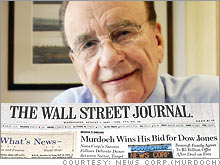The REAL reason the Bancrofts lost Dow JonesBecause of the share structure, the family had less control than owners of the New York Times and Washington Post. And guess what: The same thing could happen to Murdoch.NEW YORK (Fortune) -- If you care about business news, you know by now that Rupert Murdoch has won control of the Wall Street Journal. What you probably don't know is that even though the Journal had been thought of as a great family-controlled paper, along with the Sulzbergers' New York Times and the Grahams' Washington Post, the Bancrofts had largely checked out long ago.
Here's the deal. In 1986, Dow Jones & Co., the Journal's owner, issued a new class of stock designed to give the Bancrofts permanent control. You can argue about whether that's a good thing, though I like it when it comes to journalism companies. (In fact, my biggest single-company investment is the Washington Post Co., my employer until I joined Fortune.) But if you're going to set up family control, you ought to set it up right and have the family keep heavy skin in the game - which the Times and Post companies did, and Dow Jones did not. Now, look at this: Since 1984, when the permanent-control plan (delayed for two years by a lawsuit) was proposed to Dow Jones shareholders, the Bancrofts have sold more than 60 percent of their company stock. (See sidebar.) That being the case, you wonder why many of them even bothered to oppose Murdoch, considered by many (including me) to be the Dark Lord of journalism because his properties always seem to advance his business interests. Heaven forfend that the Bancrofts would be so tacky. In fact, the pitch for entrenching the family, presented in Dow Jones's 1984 proxy statement, was to "provide better assurance that in the years ahead the Company and its publications will continue to operate under the same quasi-public trust philosophy that the family has followed since Clarence Barron acquired the Company in 1902." Oh, well. By the time the endgame was playing out, various Bancrofts had long since given up on journalistic principle and were just trying to extract a better deal for themselves than the $60 Murdoch was offering other shareholders. They did that indirectly by getting Dow Jones (Charts) - soon to be part of Murdoch's News Corp. (Charts, Fortune 500) - to absorb Bancroft expenses that I estimate at $1.50 per family share. So much for "quasi-public trust." To see why the Sulzbergers and the Grahams are still in control while the Bancrofts will soon be gone, you have to look at not only the Bancroft family but also the kludged-up way Dow Jones tried to establish permanent family control. When the New York Times Co. (Charts) and the Washington Post Co. (Charts) went public, they had two classes of shares: family and regular. The family shares, which vote separately, control 70 percent of the board. That means you need a majority of the family shares to take control. By contrast, Dow Jones had just one class of stock before creating ten-vote B shares in 1986. Holders got one B share for each two regular, one-vote shares they owned. B shares converted to regular stock when they were sold, which is why there are now only about 20 million, rather than the original 32.6 million. B shares kept their superpowers only if you passed them on to family members or charities.
Media Biz
The flaw: a majority of Dow Jones's board is elected not by the B shares alone or by the Bancrofts alone, but by regular shares and B shares voting together. Get essentially all the regular shares and a third of the Bancrofts' B shares, and you achieve control. That's what Murdoch did. (He ended with a family majority after the issue was decided.) The real irony is that Murdoch's clan could go the way of the Bancrofts. Rupert has tried to ensure family control by, among other things, having News Corp. spend $11 billion (with shareholder approval) to buy out the big stake held by John Malone's Liberty Media. Despite what he may think, Murdoch, 76, won't live forever - and after he goes, his family's control of News Corp. is far from permanently assured. What a reversal it would be if someday we're talking about how the Murdochs lost control of their corporate patrimony the same way the Bancrofts have. Research associate Lisa Bergtraum |
| ||||||||||


